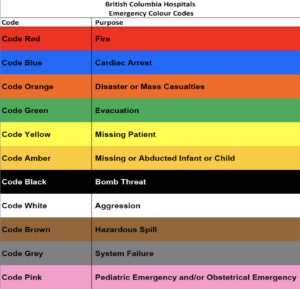Hospital Emergency Codes
Emergency response includes any systematic response to an unexpected or dangerous occurrence with the goal to quickly control the situation and lessen the impact on people and the environment. Hospital colour codes are used in hospitals worldwide to denote to staff various kinds of emergency situations. Hospital emergency codes are coded messages often announced over a public address system of a hospital to alert staff to various classes of on-site emergencies; however, have varied greatly between sites which causes confusion. In British Columbia, the use of standardized emergency codes (See Table 10.3.1) is intended to convey essential information quickly and with a minimum of misunderstanding to appropriate staff, while minimizing stress and preventing panic among clients and visitors to the hospital. Theses standardized codes ensuring staff receive a common message, signaling the need for an urgent response without unnecessarily alerting or alarming clients, residents, or visitors. Staff who are reassigned to a new facility or site or who practice in more than one facility need to be immediately familiar with a code identifying the nature of a given crisis and their expected response. In order for a code call to be useful in activating the response of specific hospital personnel to a given situation, it is usually accompanied by a specific location description (e.g., “Code Blue, seven floor, room seven-twenty”). While other codes will only signal hospital staff, as a whole, to prepare for the consequences of some external event such as a natural disaster (BC Ministry of Health Services, 2011).
Table 10.3.1: Standardized Codes in British Columbia

The following lists are examples of what may be expected of HCAs for the four most called codes at a particular site. Remember, no matter the code, be sure to follow the agency procedures:
Code BLUE:
- Activate help (this may simply involve notifying the unit clerk, LPN or RN nearest to the phone system, or emergency call button).
- Remove all obstructions from the client’s bedside and room (bedside table, chairs, etc.).
- Close the privacy drapes of any clients in the same room.
- Stand in the hallway and direct emergency personnel to the correct room.
- Be available to retrieve supplies and equipment that the code response team may require.
- Comfort any clients who may be located in the same room.
- Clean and tidy the area after the event.
Code WHITE:
- Activate help (this may simply involve notifying the unit clerk, LPN or RN nearest to the phone system or emergency call button).
- Maintain personal safety at all times.
- Stand in the hallway and direct emergency personnel to the correct room.
- Be available to retrieve supplies and equipment that the code response team may require.
- Comfort any clients who may be located in the same room.
- Clean and tidy the area after the event.
- Recognizing that a member of the interprofessional care team may not be available as a resource for HCA practice during the time they are responding to an event, identify the next appropriate care provider who will provide guidance and direction.
Code YELLOW:
- Activate help (this may involve notifying the unit clerk, LPN or RN nearest to the phone system).
- Seek direction from the interprofessional care team.
- Join unit team members in the systematic search of the unit.
- Be specific and thorough in your search processes.
- Report back to the RN or team leader as soon as your area has been searched to receive further direction.
Code RED:
- Activate help (this may simply involve notifying the unit clerk, LPN or RN nearest to the phone system or emergency call button).
- Follow the procedures as outlined by the workplace. Content is covered by on-line orientation for students doing placements at health region sites.
Summary:
In this unit, you learned about some of the types of lines, tubes, and drainage systems, and dressings that you might encounter with acute care clients. As an HCA, it is important to know how to not only provide care for such clients, but also to make observations so as to document and report alterations that may mean negative changes in the client.
Also, you learned about the standardized emergency codes used throughout British Columbia. These codes allow for healthcare organizations to mobilize staff in a quick and efficient way to address the specified emergency. As an HCA, it is important for you to know these, what your role will be during emergencies, and how to respond. It is also important to follow each agency’s procedures for using these codes.
Attributions
Table 10.3.1: Standardized Codes in British Columbia BC Ministry of Health Services. https://www2.gov.bc.ca/assets/gov/health/keeping-bc-healthy-safe/health-emergency-response/standardized-hospital-colour-codes.pdf
References
Anderson, R., Rees, G., & McCutcheon, J. (n.d.). Clinical procedures for safter patient care – Thompson Rivers University Edition. https://pressbooks.bccampus.ca/clinicalproceduresforsaferpatientcaretrubscn/
British Columbia Institute of Technology (BCIT). (2015a). Patient care for sonography. In, NURS 1186. Vancouver, BC: BCIT.
BC Ministry of Health Services. (2011). Policy Communique: Standardised Hospital Colour Codes. https://www2.gov.bc.ca/assets/gov/health/keeping-bc-healthy-safe/health-emergency-response/standardized-hospital-colour-codes.pdf
Interior Health Authority. (2016). Royal Inland Hospital- Intensive Care Unit – “Let’s take the pressure off.”
Perry, A. G., Potter, P. A., & Ostendorf, W. R. (2018). Clinical nursing skills and techniques (9th ed.). St. Louis, MO: Elsevier-Mosby.
any systematic response to an unexpected or dangerous occurrence with the goal to quickly control the situation and lessen the impact on people and the environment.
Announced coded messages to alert hospital staff to various types of on-site emergencies intended share essential information quickly and prevent visitor stress or panic.

